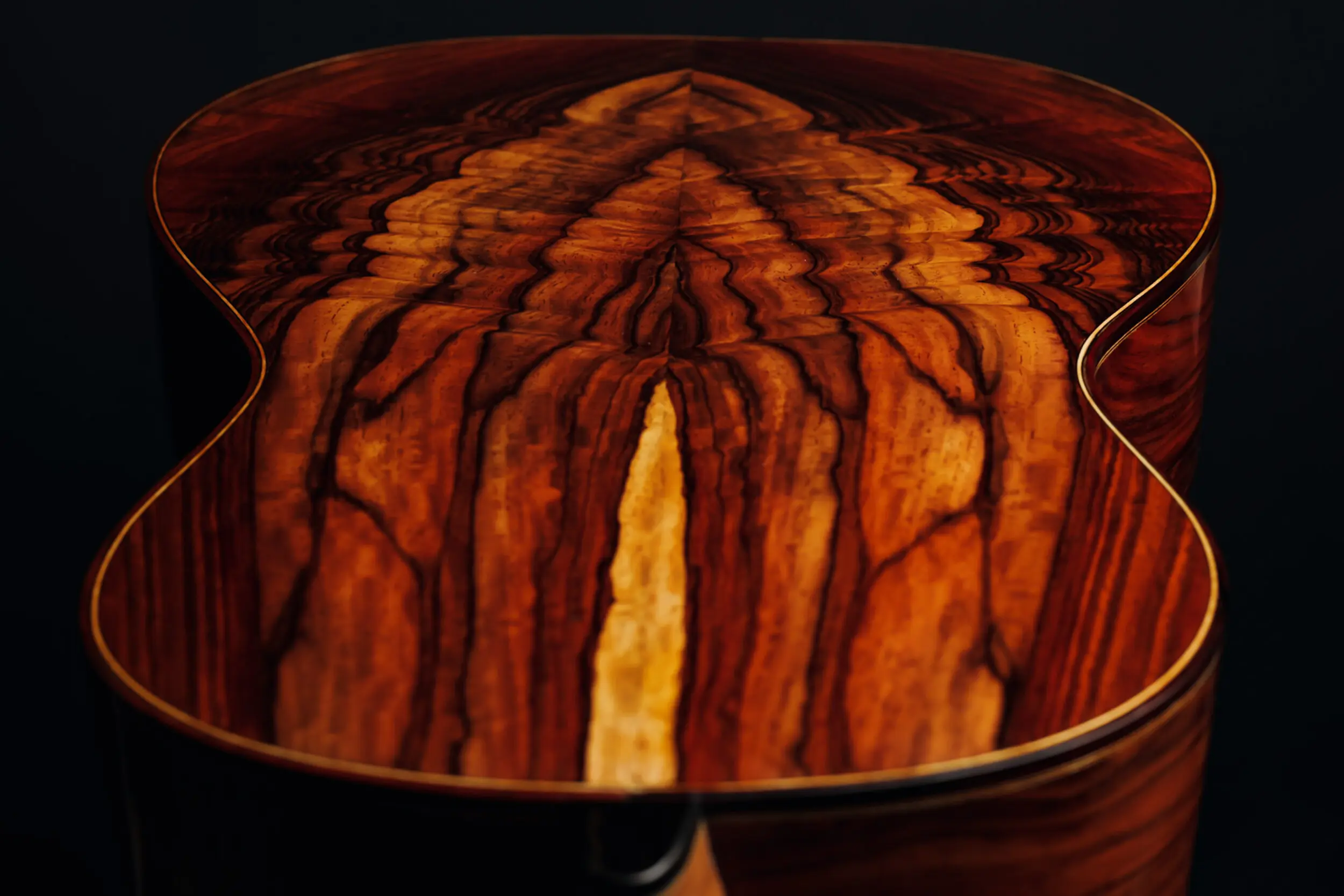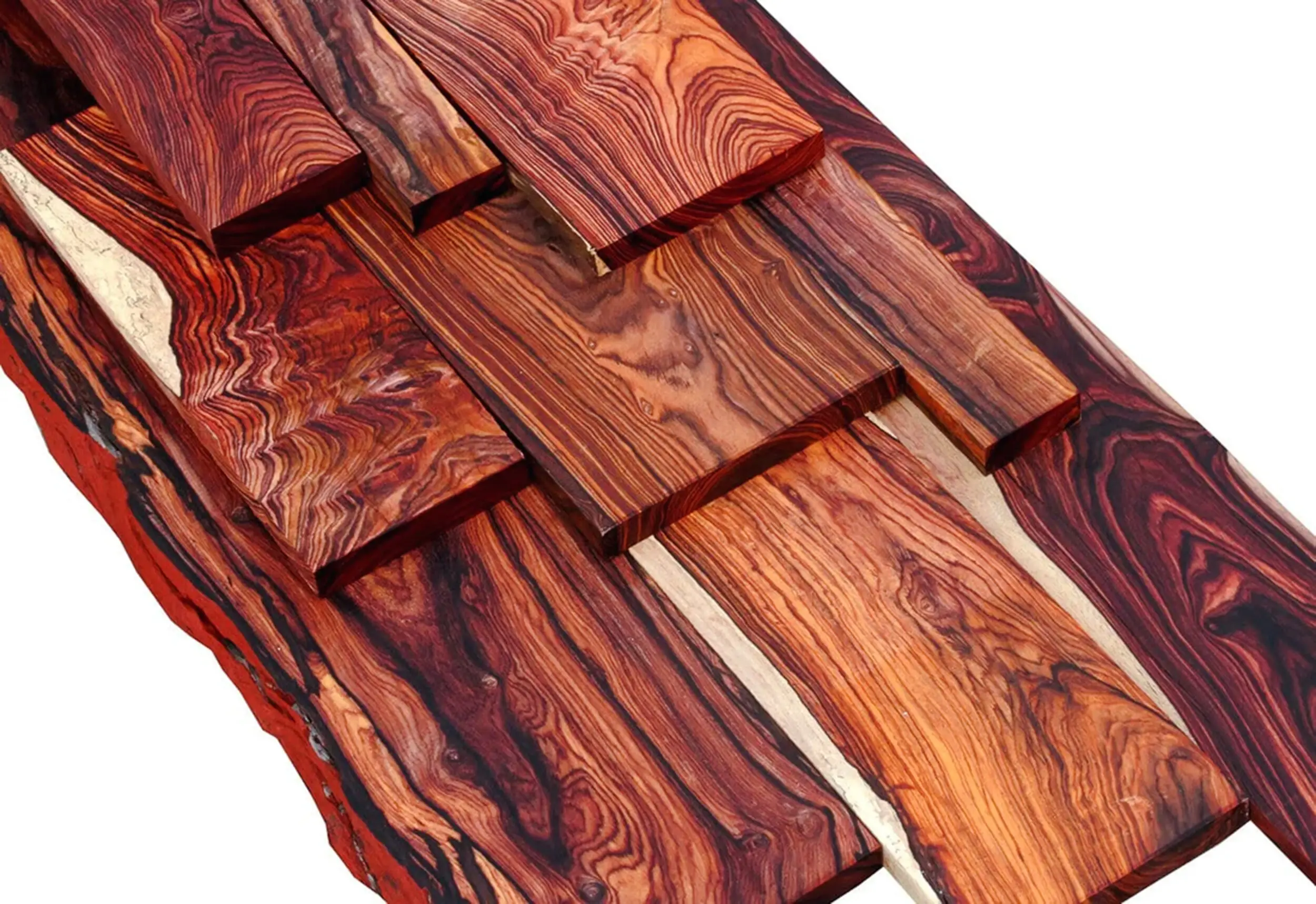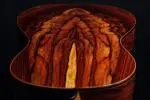Cocobolo, characterized by its monikers “redheart,” is a tropical hardwood originating from Nicaragua, Panama, and Mexico. A notable feature of this wood is its diverse color palette that varies from light pink to orange, brownish-red, and even deep red, offering a rich visual appeal to any instrument it constructs.

What is Cocobolo: Table of Contents
As we embark on our exploration of one of the hidden gems in the world of music, we acquaint ourselves with an extraordinary tropical hardwood, known to us as Cocobolo. This unique wood is rich in character, possessing a myriad of monikers that give testament to its storied history. ‘Redheart’, a name inspired by the warm, rich hues the wood sports, is one such alias that Cocobolo proudly wears. The scientific community, on the other hand, refers to it as Erythroxylon mexicanum and Dalbergia retusa, underscoring its importance in botanical studies.
This distinguished wood has deep roots in the soils of Central America, specifically sprouting from the rich biodiversity of Nicaragua, Panama, and Mexico. This geographical origin provides cocobolo with its unique set of attributes that make it a much sought-after material in the creation of musical instruments.
As we venture further into the world of Cocobolo, its vibrant color palette is one of the first features that demand our attention. The wood exhibits an extravagant range of hues, dancing between delicate light pinks and intense oranges to deep, captivating tones of brownish-red and red. This kaleidoscope of colors is the very embodiment of Cocobolo’s natural beauty, a trait that adds significant aesthetic appeal to the instruments it gives birth to.
The allure of Cocobolo, however, extends beyond its radiant colors. It presents an intriguing contrast of black and brown streaks running across its grain, enriching its visual complexity. In certain instances, a unique curly figuring surfaces, further enhancing its texture and visual appeal. This artistic display of nature’s design provides a unique and attractive canvas for the creation of beautiful, melodious musical instruments.
Structure and Composition of Cocobolo
The true allure of Cocobolo unfolds as we delve into its structural composition. It presents an enchanting spectacle of patterns, a straight grain that seems to narrate a tale of its own. This grain, an essential characteristic of Cocobolo, is woven with intricate streaks of black and brown. Like the beautiful veins of a leaf or the vibrant marbling in a slab of quality meat, these streaks give Cocobolo its distinctive appeal. Each piece is like a fingerprint, bearing unique patterns that make every instrument constructed from it one-of-a-kind.
Amidst these streaks and the straight grain, you may often find a phenomenon known as curly figuring. This term refers to the waviness or ‘curls’ that can be seen in the grain of the wood. Imagine an ocean wave caught at its peak, and then transferred onto the surface of the wood, immortalized forever. This fascinating feature brings an additional layer of complexity and texture to Cocobolo, making each instrument not just a piece of equipment, but a work of art.
On a broader scale, Cocobolo is part of the prestigious Dalbergia family. This family, or more technically, genus, is recognized for its lineage of high-quality rosewoods. Belonging to this family is akin to carrying a seal of approval in the world of wood. When an artisan hears ‘Dalbergia,’ they immediately think of durability, richness in color, and superior tonal qualities, all of which Cocobolo proudly inherits.

Cocobolo in the Musical World: The Physical Properties
In the domain of music, the choice of material for crafting instruments goes beyond mere aesthetics. The physical properties of the material play an integral role in determining the quality of sound that the instrument produces. Herein lies the charm of Cocobolo, whose physical properties set it apart and make it a preferred choice among instrument creators.
Diving into Cocobolo’s physical properties, two characteristics emerge as its defining aspects: its high density and oily nature. High density translates into a sturdier construction, lending itself to the production of robust and durable musical instruments. This quality imparts Cocobolo with a resilience that enables instruments crafted from it to stand the test of time and use.
Concurrently, Cocobolo is inherently oily, a feature that might initially seem problematic, especially when considering its influence on the crafting process. However, this oiliness proves to be a strength, bolstering Cocobolo’s resilience by naturally protecting the wood from external elements. This internal oil reservoir grants the wood an innate resistance to decay, rot, and even certain pests, ensuring the longevity of the musical instruments born from it.
But, how do these properties influence the sound, the lifeblood of any musical instrument? It all ties back to the science of sound propagation. The high density and oiliness of Cocobolo have a significant impact on the wood’s ability to resonate, essentially enhancing the sound’s travel within the instrument.
Density directly influences the speed of sound within a medium, and in the case of Cocobolo, its high density enables sound waves to travel faster. This results in clearer, brighter tones, ensuring that each note emerges distinctly. Moreover, the oily nature of Cocobolo contributes to a smoother propagation of sound waves, eliminating unwanted distortions and promoting a balanced tone.
The sum total of these physical properties is a wood that not only constructs durable and visually appealing musical instruments but also significantly influences the quality of sound they produce. With Cocobolo, you get instruments that sing with clarity, richness, and a beautiful balance of tones, taking your musical experience to a whole new level.
Cocobolo in Action: Instruments
The unique characteristics of Cocobolo shine when the wood is fashioned into musical instruments. Its resilience, rich hues, and superior resonance come together to make Cocobolo the material of choice for various instruments, particularly xylophones, guitars, and basses.
In the case of xylophones, the hard, dense nature of Cocobolo is perfect for crafting the bars of the instrument. Since a xylophone’s sound is produced when mallets strike these wooden bars, the hardness and density of Cocobolo are critical for producing a crisp, clear sound. Furthermore, the high oil content enhances the longevity of the bars, ensuring that they continue to produce high-quality sound over time.
When it comes to guitars and basses, Cocobolo’s density and oil content prove advantageous once again. Its high density ensures a faster, brighter sound, enhancing the clarity of each note. This is especially important for basses, where clear, deep notes are paramount. Moreover, the wood’s oil content aids in achieving a smoother sound propagation, leading to a balanced tone that is desirable in both guitars and basses.
Comparing Cocobolo to other types of rosewood used in instrument construction, we find several similarities and differences. Like its rosewood counterparts, Cocobolo is known for its density, oil content, and ability to produce excellent sound quality. However, Cocobolo tends to be denser and oilier than most other rosewoods, leading to enhanced durability and a distinct tonal quality.
While other rosewoods often produce warm, mellow tones, Cocobolo’s sound tends to be brighter and clearer, thanks to its high density. Additionally, the high oil content of Cocobolo gives it an edge in terms of natural protection and longevity.
Challenges and Considerations in Handling Cocobolo
While the many virtues of Cocobolo paint an enticing picture, it is crucial to remember that working with this wood is not without its challenges. These considerations stem primarily from Cocobolo’s physical properties, which, while beneficial for the final product, can pose hurdles during the construction process.
The very same oily nature that imparts Cocobolo its durability and resonance poses a unique challenge when it comes to gluing. The oils in the wood can prevent the glue from adhering properly, making it difficult to join pieces of Cocobolo together. This can complicate the assembly process for musical instruments, requiring extra steps like pre-treatment of the wood to ensure a strong bond.
In addition to the challenges in gluing, there’s an occupational hazard associated with Cocobolo. The dust produced from sanding or cutting Cocobolo can trigger allergic reactions in some people. These reactions can range from mild, like skin irritation, to severe, such as respiratory distress, underscoring the importance of taking precautions when working with Cocobolo.
When handling Cocobolo, it is imperative to use proper safety equipment. Woodworkers should wear gloves to protect their skin from potential allergic reactions. Also, the use of masks or respirators is crucial to prevent inhalation of Cocobolo dust. Ensuring a well-ventilated workspace can also aid in dispersing the dust, reducing the chances of triggering an allergic response.
Moreover, pre-treating the wood with a solvent can help remove some of the oils from the surface, making it easier to glue. Alternatively, specific types of adhesives designed to work with oily woods can also be used.
Advantages of Cocobolo: No Finish Required and Humidity Resistant
Despite the challenges posed by Cocobolo’s oil-rich nature, there are also remarkable advantages that come along with it. One of these is the absence of the necessity for a finish. Most types of wood require some sort of finish, be it varnish, lacquer, or oil, to protect them from external elements and enhance their appearance. However, Cocobolo’s inherent oil content provides it with a natural finish.
This oil-rich nature brings a natural luster to the surface of the wood, amplifying its vibrant hues and intricate grain patterns. When polished, Cocobolo exudes a radiance that gives a premium, high-quality appearance to the instruments it constructs. Therefore, bypassing the need for a finish reduces the overall manufacturing process time and preserves the authenticity of Cocobolo’s natural charm.
In addition to this, Cocobolo’s oiliness offers another significant advantage—resistance to humidity. Humidity is often a cause for concern in the world of musical instruments. It can lead to warping or cracking of the wood, affecting both the aesthetics and sound quality of the instrument. However, Cocobolo’s oil content acts as a natural barrier, preventing the absorption of moisture and protecting the wood from the damaging effects of humidity.
Instruments made from Cocobolo are more likely to retain their shape and tuning stability even in fluctuating environmental conditions. This makes them ideal for use in various climates and guarantees a consistent sound quality. This benefit is particularly valuable for touring musicians who often have to play in different climates and humidity levels.
In conclusion, the oil-rich nature of Cocobolo, which poses challenges in some aspects of instrument making, is a boon in other ways. It not only gives the instruments a natural finish and a vibrant look but also shields them from the potential harm caused by humidity. Thus, despite its quirks and demands, Cocobolo’s advantages make it an excellent material for crafting exquisite, high-performing musical instruments.

